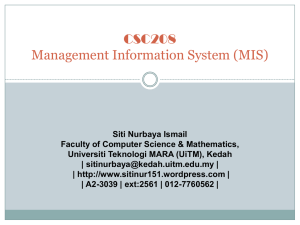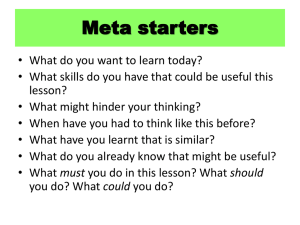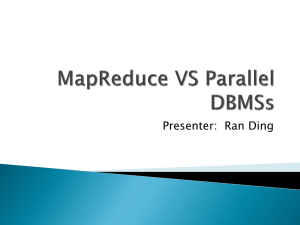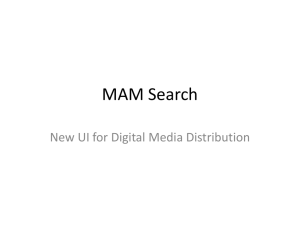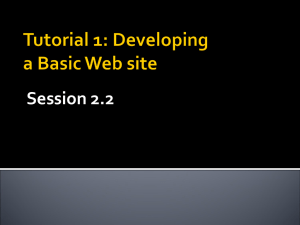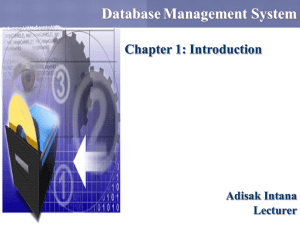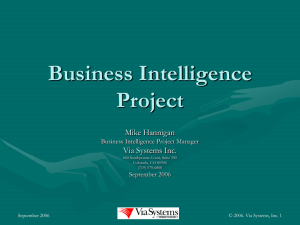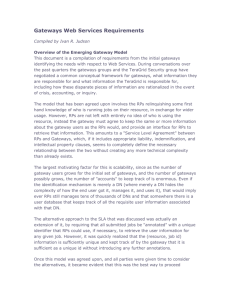Step2-3 - E-Commerce Security
advertisement
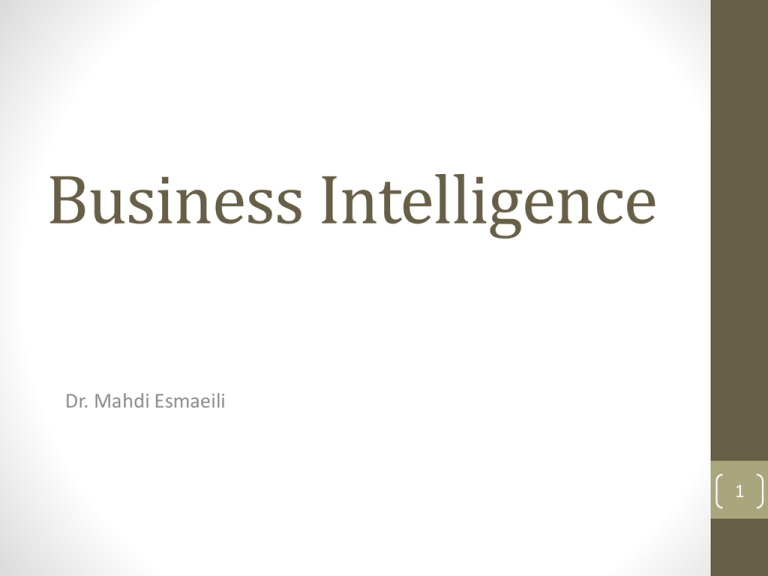
Business Intelligence Dr. Mahdi Esmaeili 1 Step 2: Enterprise Infrastructure Evaluation Technical Infrastructure Evaluation Hardware Network Middleware Database Management Systems Tools and Standards Nontechnical Infrastructure Evaluation Logical Data Model Meta Data Standards, Guidelines, and Procedures 2 Controlled Hardware Chaos • New hardware platforms have to fit into the existing hardware configuration. • The DBMS on the selected hardware platform must perform well as database access and usage grow. Scalability is therefore one of the major issues to be addressed. • Platform selection is restricted by the need for interoperability between various hardware platforms (if required). • Cost and return on investment (ROI) for the previous three qualifiers are controlling factors 3 Hardware must also be scalable because rapid changes will occur in: • • • • • • • Data volumes Updating frequencies Data access patterns Number of reports and queries Number of people accessing the BI target databases Number of tools running against the BI target databases Number of operational systems feeding the BI target databases 4 Three-Tier Computing Architecture 5 middleware • Distributed logic middleware • Data management middleware 6 Gateway Example 7 DBMS Gateways • • • • Point-to-point gateways Gateways that can be used universally Gateways using Structured Query Language (SQL) Gateways based on application programming interfaces (APIs) 8 Criteria for Selecting a DBMS • Degree of parallelism in handling queries and data loads • Intelligence in handling dimensional data models and optimizers • Database scalability • Internet integration • Availability of advanced index schemes • Replication on heterogeneous platforms • Unattended operations 9 10 Deliverables Resulting 1. Technical infrastructure assessment report - Servers - Client workstations - Operating systems - Middleware (especially DBMS gateways) - Custom interfaces - Network components and bandwidth - DBMS functionality and utilities (backup and recovery, performance monitoring) - Development tools such as computer aided software engineering (CASE) and ETL tools - Access and analysis tools such as OLAP tools and report writers - Meta data repository 2. Installation of selected products If you identified new products to purchase, write a request for proposal (RFP) or a request for information (RFI) 11 Roles Involved in These Activities • BI infrastructure architect • Database administrator Risks of Not Performing Step 2 Technology advances occur every few months 12 Creating Nontechnical infrastructure involves cross-organizational activities such as: • • • • • • • • • Conduct an extensive business analysis Adopt a system of peer reviews Resolve age-old disputes about data definitions and domains Standardize data names and data values Get agreement from the business people Create a regular forum for business people Create a meta data repository Create an inventory of source data Create and manage one expanding central staging area (per load periodicity) for the ETL processes 13 Enterprise Architecture Group A central enterprise architecture group must manage and coordinate Enterprise infrastructure activities 14 Enterprise Architecture Components 15 Enterprise Standards 16 17 Deliverable Resulting 1. Nontechnical infrastructure assessment report - Standards - Use of a development methodology - Estimating guidelines - Scope management procedure - Issues management procedure - Roles and responsibilities - Security process - Meta data capture and delivery - Process for merging project-specific logical data models into the enterprise logical data model - Data quality measures and triage process - Testing process - SLAs - Support function - Dispute resolution procedure - Communication process 18 Roles Involved • • • • BI infrastructure architect Data administrator Data quality analyst Meta data administrator 19 Step 3: Project Planning What will be delivered? When will it be done? How much will it cost? Who will do it? 20 Quality Typical Order Recommended Order Effort (Time) Quality Scope Budget Budget Resources Resources Effort (Time) Quality Scope 21 project charter • • • • • • • Goals and objectives Scope (80/20 Data/Function) Risks Constraints Assumptions Change-control procedures Issues management procedures The project charter is the agreement made between the business sponsor and the IT staff for developing the BI application 22 preparing a project plan • Create a work breakdown structure listing activities, tasks, and subtasks. • Estimate the effort hours for these activities, tasks, and subtasks. • Assign resources to the activities, tasks, and subtasks. • Determine the task dependencies. • Determine the resource dependencies. • Determine the critical path based on the dependencies. • Create the detailed project plan. 23 24 Deliverables Resulting 1.Project charter - Goals and objectives (both strategic goals for the organization and specific objectives for the BI project) - Statement of the business problem - Proposed BI solution - Results from the cost-benefit analysis - Results from the infrastructure gap analysis (technical and nontechnical) - Functional project deliverables (reports, queries, Web portal) - Historical requirements (how many years of history to store) - Subject area to be delivered - Entities (objects), significant attributes, relationships (high-level logical data model) - Items not within the project scope (originally requested but subsequently excluded from the scope) - Condition of source files and databases - Availability and security requirements - Access tool requirements - Roles and responsibilities - Team structure for core team and extended team members - Communication plan - Assumptions - Constraints - Risk assessment - Critical success factors 2.Project plan A project plan may contain multiple graphs (such as a CPM chart, a Pert chart, or a Gantt chart) detailing task estimates, task dependencies, and resource dependencies. Most project-planning tools can also produce additional tabular reports on resources and schedule. 25 Roles Involved in This Step • • • • • • • • • Application lead developer Business representative Data administrator Data quality analyst Database administrator ETL lead developer Meta data administrator Project manager Subject matter expert 26
